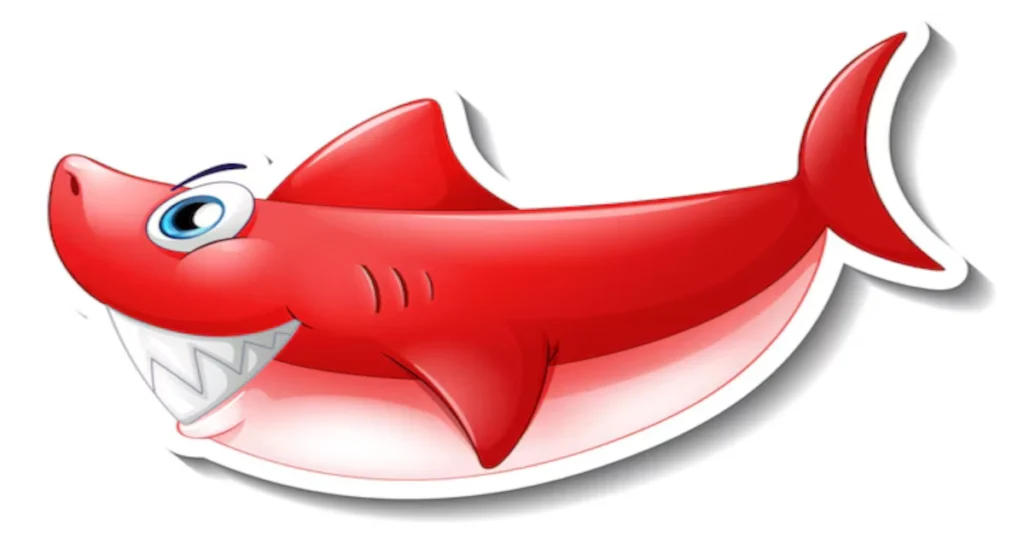The Ultimate Guide to Red Tip Shark Care: Tips for a Healthy Aquarium
The “Red Tip Shark,” also known as the Red-Finned Shark or Ruby Shark (scientific name Epalzeorhynchos frenatum), is a popular freshwater fish cherished by aquarium enthusiasts for its striking appearance and dynamic behavior. While not an actual shark, this member of the Cyprinidae family has a shark-like body shape and a vibrant red tail that makes it highly recognizable. Native to rivers and streams in Southeast Asia, these fish add a dynamic flair to any aquarium due to their unique look and active personalities.
In this article, we’ll cover everything you need to know about the Red Tip Shark, including its habitat, behavior, dietary needs, tank setup, and care requirements. We’ll also explore common misconceptions, potential tank mates, and helpful tips for beginners and seasoned aquarists alike.
1. Overview of the Red Tip Shark
The Red Tip Shark is a medium-sized freshwater fish with an impressive red tail fin that sets it apart from other species. Its sleek, torpedo-shaped body and dorsal fin make it look like a miniature shark, which is why it has earned the “shark” label. Unlike real sharks, however, the Red Tip Shark is entirely harmless to humans, though it can be territorial in certain environments.
Scientific Classification:
- Kingdom: Animalia
- Phylum: Chordata
- Class: Actinopterygii
- Order: Cypriniformes
- Family: Cyprinidae
- Genus: Epalzeorhynchos
- Species: E. frenatum
Natural Habitat:
Red Tip Sharks are native to Thailand, Cambodia, and Laos, where they inhabit rivers, streams, and flooded forests. They thrive in areas with slow-moving water and dense vegetation.
2. Physical Characteristics and Identification
Red Tip Sharks are visually captivating due to their striking colors and streamlined body shape. They typically grow to an adult size of around 6 inches (15 cm) in length, although some can reach up to 7 inches in captivity.
Key Features:
- Body Shape: Torpedo-like, with a streamlined body ideal for swimming.
- Color: Mostly black or dark gray, with a bold red tail fin.
- Fins: Dorsal fin resembling that of a shark, giving it a distinctive appearance.
- Lifespan: Typically 5 to 8 years with proper care, though some may live longer.
This unique color combination and sleek body shape make the Red Tip Shark one of the more visually appealing species for aquarists looking to add personality to their tank.
3. Behavior and Temperament
Red Tip Sharks are known for their semi-aggressive temperament. While they aren’t dangerous to humans, they can exhibit territorial behavior, especially in smaller tanks or if housed with similar-looking fish. Understanding their behavior is crucial for successfully keeping them in a community tank.
Behavioral Traits:
- Territorial: Red Tip Sharks may become territorial as they mature, particularly with fish that have similar body shapes or colors.
- Active Swimmers: They’re constantly moving and exploring, adding a dynamic element to the tank.
- Shy but Assertive: Often shy at first, they can become assertive once they establish territory, so providing hiding spots and space is important.
4. Ideal Tank Setup for Red Tip Sharks
Creating a suitable environment for a Red Tip Shark is essential to ensure their health and happiness. Here’s a breakdown of what an ideal tank should look like:
Tank Size:
- Minimum tank size: 55 gallons (200 liters) for a single Red Tip Shark.
- Larger tanks are preferred if you plan to house multiple fish, as this reduces territorial aggression.
Water Parameters:
- Temperature: 72-79°F (22-26°C)
- pH Level: 6.5 to 7.5
- Water Hardness: Soft to moderately hard (5-15 dGH)
- Filtration: High-quality filtration is essential, as Red Tip Sharks are sensitive to poor water conditions.
Decor and Hiding Spaces:
Red Tip Sharks are natural explorers and appreciate an environment that mimics their native habitat. Here are some ideas:
- Substrate: Use sand or smooth gravel to prevent injury.
- Plants: Add live or artificial plants to provide cover and reduce stress.
- Hiding Spots: Use rocks, driftwood, and caves to create hiding spaces.
- Open Swimming Space: Leave open areas for swimming as they’re highly active.
Lighting:
Moderate lighting works best, as bright light can make them more reclusive.
5. Diet and Feeding
Red Tip Sharks are omnivores, which means they require a balanced diet of plant-based and protein-rich foods. A well-rounded diet keeps their colors vibrant and promotes overall health.
Recommended Foods:
- Commercial Pellets and Flakes: High-quality sinking pellets designed for omnivores.
- Vegetable Matter: Blanched vegetables like spinach, zucchini, and peas.
- Protein: Frozen or live foods such as bloodworms, brine shrimp, and daphnia.
- Algae Wafers: Supplement their diet with algae wafers to ensure adequate fiber intake.
Feeding Frequency:
- Feed them twice a day in moderate quantities to prevent overfeeding and maintain water quality.
6. Tank Mates and Compatibility
When it comes to selecting the right tank mates for your Red Tip Shark (also known as the Red-Finned Shark), it’s essential to consider their territorial nature. Although these fish can make great community tank residents, choosing compatible species is key to maintaining a peaceful environment. The Red Tip Shark is typically non-aggressive but will fiercely defend its territory, especially when introduced to new environments or in confined spaces. Below, we’ll explore compatible tank mates, species to avoid, and helpful tips to ensure everyone in the tank gets along.
Compatible Tank Mates
- Bottom Dwellers
Fish that inhabit the lower regions of the tank, such as Catfish (e.g., Plecostomus or Corydoras) and Loaches, are great companions for Red Tip Sharks. These fish typically stay out of the shark’s preferred mid-water zone and occupy the bottom of the tank, which minimizes competition for space. Since these bottom dwellers are generally peaceful and unobtrusive, they coexist well with more territorial species like the Red Tip Shark. Catfish and loaches also help maintain a clean tank by feeding on leftover food and detritus. - Large Tetras
Large, fast-moving species of Tetras, like the Black Skirt Tetra or Buenos Aires Tetra, make excellent tank mates for Red Tip Sharks. These species are active swimmers, which reduces the likelihood of them being intimidated or harassed by the shark. Their speed and size help them avoid territorial disputes, and their social behavior can add to the liveliness of your community tank. However, always avoid smaller Tetras, as their tiny size may make them more vulnerable to being bullied. - Rainbowfish
Rainbowfish are another fantastic option. Known for their vibrant colors and active nature, Rainbowfish are peaceful and not territorial, making them ideal companions for Red Tip Sharks. Their playful behavior and ability to live in schools also help diffuse any tension that may arise in the tank. Rainbowfish thrive in similar water conditions to Red Tip Sharks, creating an overall harmonious environment in the aquarium.
Tank Mates to Avoid
- Similar Species
While it may be tempting to add other species of sharks, it’s advisable to avoid fish that resemble the Red Tip Shark, such as Bala Sharks or Rainbow Sharks. These species can exhibit the same territorial behavior, leading to aggression and potential stress for all involved. The introduction of similarly-shaped fish can result in constant battles for dominance, creating a hostile environment in your aquarium. - Small or Slow Swimmers
Fish that are slow or particularly small are also not ideal for a tank with Red Tip Sharks. Species like Guppies, Neons, and Goldfish can easily become targets of aggression. The Red Tip Shark may chase, nip, or even injure smaller fish as it seeks to establish and defend its territory. Slow-moving species are particularly vulnerable as they lack the agility to escape from the shark’s aggressive behavior.
Tips for Compatibility
- Provide Ample Space
The more space you provide in the tank, the less likely your Red Tip Shark will feel the need to defend its territory. A larger aquarium with plenty of open swimming areas can help mitigate territorial aggression. Aim for a tank that is at least 50 gallons for one Red Tip Shark and even larger if you plan on adding other fish. A spacious setup ensures that your Red Tip Shark can claim its own area without encroaching on others’ spaces. - Add Plenty of Hiding Spots
To further reduce stress and territorial disputes, add rocks, caves, plants, and other decorations where fish can retreat to. This gives the less dominant species a safe haven and makes them feel more secure. Red Tip Sharks, although territorial, will usually only defend their personal space. Offering hiding spots for all tank mates helps maintain peace in the aquarium. - Introduce Red Tip Sharks Last
If you’re adding a Red Tip Shark to an established community tank, it’s best to introduce it last. This ensures that the shark does not claim the entire tank as its territory before other fish have had a chance to settle in. When introduced last, the shark is less likely to engage in territorial disputes and is more likely to adapt peacefully to the community tank environment. - Monitor Behavior
Keep an eye on your fish and their behavior, especially in the initial stages after introducing a new tank mate. If you notice signs of aggression or stress, it may be necessary to rearrange the tank layout or consider rehoming certain fish. Early intervention can prevent serious issues down the line.
By selecting the right tank mates, ensuring plenty of space and hiding spots, and introducing your Red Tip Shark carefully, you can maintain a harmonious community tank where all your fish can thrive together. Keep in mind that each fish has its own personality, so always be ready to make adjustments for the well-being of all your aquatic pets.
7. Health and Common Diseases
Red Tip Sharks are relatively hardy but can suffer from common aquarium diseases if water quality isn’t maintained.
Common Health Issues:
- Ich (White Spot Disease): Characterized by white spots on the body and fins; treatable with medication.
- Fin Rot: Often a result of poor water conditions; ensure a clean environment and treat with antibiotics if needed.
- Bacterial Infections: Signs include red streaks or swelling; treat with antibiotics.
Prevention Tips:
- Maintain Clean Water: Regular water changes are essential.
- Monitor Water Parameters: Use a water testing kit to check pH, hardness, and ammonia levels.
- Quarantine New Fish: Always quarantine new additions to prevent disease spread.
8. Breeding Red Tip Sharks
Breeding Red Tip Sharks in captivity is challenging, even for experienced aquarists. While they have been bred in commercial settings, it is rarely successful in home aquariums due to their specific breeding requirements.
Key Challenges:
- Aggression: Males can be aggressive towards females.
- Environmental Needs: They require specific water conditions and setup to breed.
- Egg-Scatterers: If breeding does occur, they scatter their eggs, which can be challenging to protect from other tank inhabitants.
10. Conclusion
The Red Tip Shark is an appealing and active addition to any freshwater aquarium, thanks to its bold coloration and shark-like appearance. However, keeping a Red Tip Shark requires careful consideration of tank setup, water conditions, and compatible tank mates to create a harmonious environment. With the right care, they can thrive and bring a dynamic presence to your aquarium.
Whether you’re an experienced aquarist or looking to add a splash of color to your tank, the Red Tip Shark offers a unique and engaging option. By following the guidelines in this article, you’ll be well on your way to providing a comfortable home for this fascinating species.
Frequently Asked Questions (FAQs)
What makes the Red Tip Shark a popular choice for aquariums?
The Red Tip Shark stands out for its vibrant red tail and sleek, shark-like appearance, adding visual appeal to freshwater aquariums. It’s a favorite among hobbyists for its active nature, making it an exciting choice for aquarists seeking a unique fish.
How much space does a Red Tip Shark need in a home aquarium?
A Red Tip Shark requires a tank size of at least 55 gallons to thrive, with more space being ideal if housed in a community tank. Providing ample room helps minimize territorial aggression, ensuring a healthier, more peaceful environment.
Are Red Tip Sharks aggressive toward other fish?
Red Tip Sharks can exhibit territorial behavior, especially with similar-looking fish. While generally manageable, their behavior can escalate in smaller tanks or with certain species, so selecting compatible tank mates and ensuring plenty of space is essential.
How should I care for the Red Tip Shark’s diet and feeding schedule?
Red Tip Sharks are omnivores and benefit from a varied diet that includes sinking pellets, blanched vegetables, and occasional protein-rich treats like brine shrimp. Feeding twice daily in moderate amounts ensures balanced nutrition without overfeeding.
What water conditions are best for a Red Tip Shark?
Red Tip Sharks thrive in water temperatures between 72-79°F with a pH of 6.5-7.5 and soft to moderately hard water. Maintaining clean, well-filtered water is crucial to their health, along with regular monitoring to prevent common health issues.
Can Red Tip Sharks be bred in a home aquarium?
Breeding Red Tip Sharks in home aquariums is challenging, primarily due to their specific environmental needs and the territorial behavior of mature males. While breeding is rare, it can occasionally happen with carefully controlled conditions and spacious tanks.
READ ALSO: Purses for Work: Choosing the Perfect Professional Bag to Complement Your Career







